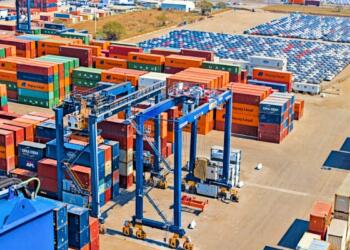
PUERTO VALLARTA, JAL.- Inefficiencies in the logistics chain are a burden that Mexico pays dearly for, according to executives of major shipping lines on a global scale.
A container ship can spend an average of five days “anchored” waiting to be served in one of the country’s main ports. The cost for each of these days of waiting time is around 50 thousand dollars for the shipping lines , an expense that is inevitably passed on to their clients.
“When I saw how much we charged in demurrage per year, I was really surprised, because while it is true that it is an important income in the structure of the shipping companies, it does not have to be the essence,” said Javier Moreira, country manager of CMA CGM in Mexico , during his participation in the XXVIII Annual Congress of Shipping Agents, organized by the Mexican Association of Shipping Agents (Amanac) .
” The system is inefficient ,” the manager concluded.
The time it takes for a ship to be served by a port terminal is also reflected in the times and costs of the services provided by other actors in the logistics chain of the goods, such as customs agents, freight forwarders, trucking companies and railways.
“All of this has an impact, all of this costs additional money,” said Torsten Nolting, vice president of Hapag-Lloyd in Mexico , who also agreed with Moreira in pointing out that “what is a disaster are the logistical inefficiencies in this country.”
The operational reality in the main Mexican ports is that the demand for cargo loading and unloading services has been exceeded by the capacity of the installed infrastructure , according to Patricia Pérez, general director of Maersk in Mexico .
According to the Average Time Index for Motor Transport in Ports (ITPAP) , published by T21 Business Intelligence, last August a motor transport unit took just over 13 hours to load imported merchandise in one of the main ports in Mexico (Manzanillo, Lázaro Cárdenas, Veracruz and Altamira) , a measurement that is divided into waiting time, maneuvering and customs, the latter being the most time-consuming.
Just a month earlier the average time had been just over 29 hours .
This delay occurs at a historic moment for ports and terminals in Mexico in the handling of merchandise. From January to August of this year, a total of six million 221 thousand 334 20-foot containers were handled , an increase of 14.8% compared to the same period last year, according to data from the General Coordination of Ports and Merchant Marine (CGPMM) of the Secretariat of the Navy .
During her participation in the Amanac congress, Patricia Pérez stressed that Mexico urgently needs to increase its port infrastructure to meet the high demand that is occurring and will continue.
“Mexico is lagging behind,” said the executive, noting that international organizations have recommended that countries place their investments in infrastructure in a range between 4 and 8% of their gross domestic product, but in Mexico this level has been less than 3% in recent years, except for 2022.
Pérez’s statement comes at a time when the main port terminal operators are unleashing investments to expand their facilities, both in docks and in maneuvering yards , and it has even been indicated that the new Government of Mexico, headed by President Claudia Sheinbaum, will take as one of its main infrastructure investment projects the development of the Cuyutlán lagoon , south of the port of Manzanillo, the busiest in the country in terms of container volume, which would help relieve the current saturation.
The three executives of the world’s leading shipping lines (Maersk second, CMA CGM third and Hapag-Lloyd fifth, measured by the number of ships and containers under their management) agreed that both authorities and companies have to overcome these inefficiencies in the logistics chain so that the extraordinary costs resulting from this are not passed on to the consumer , who ultimately ends up paying.
Comment and follow us on X: @EnriqueDuRio / @GrupoT21















